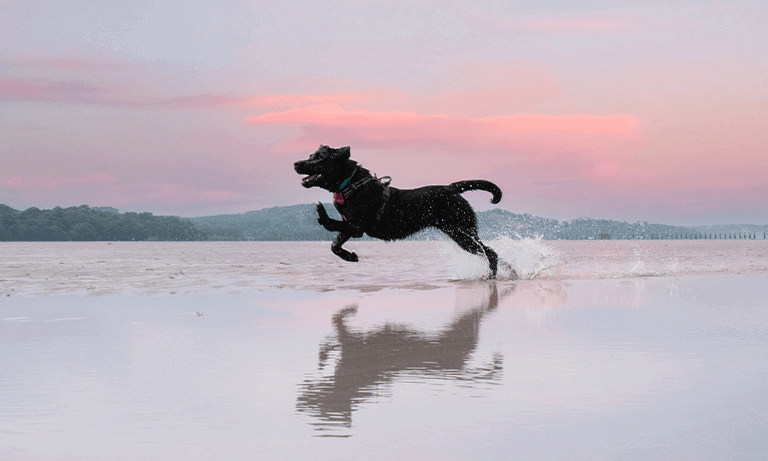Brucella canis: what vets need to know
14 Feb 2024
18 Jul 2022 | Emily Hall | Animal Health
How do you know if your dog is coping in the heat? With record summer temperatures forecast, researchers from the Royal Veterinary College (Dan O'Neill) and Emily Hall and Dr Anne Carter from Nottingham Trent University share what every dog owner needs to know about heat-related illness to keep their dog safe in hot weather.

When the body gets too hot, various mechanisms kick in to try to cool it back down to a safe temperature. In humans, these mechanisms include sweating, drinking more and trying to move away from the heat into the shade. In dogs, panting is the main mechanism for cooling, but they will also drink more, seek shade, and even seek water to jump into when they get too hot. If these cooling mechanisms don’t work, if the environment is too hot for them to be effective, or if they can’t escape the heat, then body temperatures continue to climb. Above a certain point (around 43°C), irreversible damage starts to occur. This is heat-related illness, and can lead to organ failure, brain damage and ultimately death.
Most people know that #DogsDieInHotCars, but did you know that over ten times as many dogs need veterinary treatment for heat-related illness following exercise as for being overheated in cars?
Just as some people cope better in hot weather than others, different dogs react in different ways to heat. But there are some key principles to understand about how your dog keeps cool that could help you recognise when it might be too risky to take your dog out in the heat:
Dogs receive veterinary treatment for heat-related illness following exercise all year round, so this isn’t just a summer problem. That said, the majority of heat-related illness does happen to dogs in July, so in hot summer weather any dog can be at risk.
Dogs with an underlying condition affecting their breathing are at greater risk of heat-related illness, but there are some other risk factors to be aware of. Some breeds are at greater risk of heat-related illness from exercise: Chow Chow, Bulldog, French Bulldog, Greyhound, Springer Spaniel, Cavalier King Charles Spaniel, Pug, Boxer, Golden Retriever and Border Collie.
Some of these breeds may seem surprising- the Greyhound, Springer Spaniel and Border Collie are all typically athletic, working breeds so why would they be at increased risk? The honest answer is we don’t know; heat-related illness is a complex disorder and we need more research. Temperament may well play a part; both Springer Spaniels and Border Collies are highly motivated, active breeds so they may be more likely to continue running and playing even when they’re getting too hot. Having a thick coat is likely to be a factor for Chow Chows and Golden Retrievers, and difficulty breathing (and therefore panting) is likely to be a factor for flat-faced breeds like Bulldogs and French Bulldogs.
Older dogs are also at greater risk, likely due to age related disorders such as heart disease, poorer circulation and laryngeal paralysis. As we’ve already mentioned, overweight dogs are also at increased risk of heat-related illness from exercise. Their extra fat limits heat loss from the skin to the surrounding air and limits the effectiveness of panting (as fat in the chest cavity limits lung capacity).
Learn the early warning signs so you can avoid your dog being put at risk in the first place and you can respond effectively if your dog does overheat.
If your dog seems unwell or develops a new cough or noise when breathing, then you should avoid exercise in the heat and seek veterinary advice. If you know your dog has an underlying condition, then take extra care in hot weather or consider skipping walks altogether.
We urge every dog owner to know the early warning signs of heat-related illness:
These are all signs of potential mild heat-related illness and may indicate that your dog is too hot. You need to stop them exercising, you may need to cool them down (move them into the shade, let them lie in water or pour it over them) and you should speak to a veterinary professional immediately. If your dog does not cool down quickly, their condition could become more serious with moderate signs including excessive drooling, vomiting, diarrhoea, collapse and even fitting. The most severe form of heat-related illness can lead to blood in the vomit/diarrhoea, constant or repeated fitting, and eventually complete loss of consciousness. Once dogs develop severe heat-related illness, their chances of survival drop below 50%, whereas over 95% of dogs presented for veterinary care with mild-moderate disease survive.
Find out more about heat-related illness in dogs, including how to keep dogs cool and how to spot the signs of heat-related illness at heatstroke.dog
Get tailored news in your inbox and online, plus access to our journals, resources and support services, join the BVA.
Join Us Today